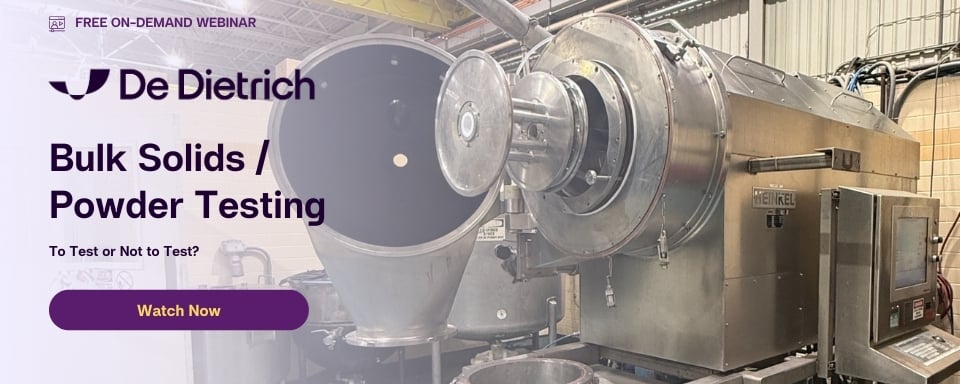The Importance of Testing your Powder's Characteristics for Pneumatic Transfer
 This post has been updated from it's original format and republished on our blog.
This post has been updated from it's original format and republished on our blog.
Testing equipment is a wise and practical thing to do before fully investing in any technology that's new to your process. Regardless of whether your application and product are conventional or unique, you still want to have some sort of assurity that it's not going to totally fail once your system is installed and put into operation.
When it comes to solids handling systems specifically designed to transfer powder, you definitely want to make sure your material is going to move from where it is to where you want it to be before you commit to making the purchase.
Testing, however, is not always possible. That is to be expected, especially when you are dealing with chemicals that come with their own unique set of characteristics and dangers; but when it is possible, it can save you a lot of strife. Isn't it better to find out converying issues early into the project than in the 11th hour?! And looking at the flip side, isn't it nice to have total confidence in a system prior to start-up than to be standing there crossing your fingers that it works as you were hoping it would? So when you do have the chance to test out prospective equipment it is definitely worth taking advantage of the opportunity to fully ensure it will be a success.
After researching technologies/equipment and identifying the top candidates for carrying out your transfer objectives, it’s a good time to find out what type of testing and/or equipment rental options are available. This will be especially helpful if you need to win the approval of a colleague or manager who will be wanting solid evidence of the equipment's suitability.
If no testing is possible but it’s a quality piece of equipment you feel strongly about, it’s important to obtain whatever data the manufacturer can provide to help assure it will effectively integrate into your process. If product testing is possible, then determining where the testing is conducted and what type of services the manufacturer can provide are some top questions to ask.
Whether testing is available or not, the next step is to supply the vendor with detailed information about your product to be transferred (see our Powder Handling Application Questionnaire as an example of the type of information they will want to know). This will help the manufacturer identify possible issues that may present themselves prior to the actual test run, and to prequalify your product as a good candidate for the technology based on its characteristics, in combination with the objectives you are trying to achieve.
Along with the obvious advantage of seeing first-hand how well your product transfers, an additional benefit to conducting product testing is the opportunity it gives both you and the equipment manufacturer to develop new technical solutions to solve any potential problems that may present themselves during the testing phase. Overcoming hurdles you encounter early on will give you the assurance you need when making your ultimate decision to purchase the equipment.
Every application is unique in some way, so the ability to modify a process to create a customized solution can play a key role in your decision-making if in fact any customization is required to provide a solution to your process requirements. And what better guarantee is there than to have documented proof that the final system design will efficiently accomplish your powder handling objectives?
At De Dietrich Process Systems, we provide Powder Pump rental units for testing at your site, as well as in-house testing (on or off-site testing depends on your product physiognomies, among other factors).
In-house testing at our Charlotte, NC facility is conducted using QVF glass Powder Pump units. Testing with a glass unit lets you watch what is going on inside the Powder Pump, allowing us to observe the powder behavior and see how quickly the unit fills. This added visibility helps us optimize your transfer settings and accurately determine:
- How fast and far the powder will move
- If there is a serious risk of plugging the transfer hose
- Where to set the initial cycle times
- Does the material blind the filter element quickly
- Does the filter media capture the particles efficiently
- How much gas pressure does it take to discharge the material
- Does the material discharge easily or bridge across the outlet valve
- Can the transfer hose be cleaned out easily
If your material is too toxic to easily transport, it is best to perform the testing at your site with our rental equipment. This method of testing will help to determine:
- All of the above (but not as easily as with the glass units, due to limited visibility)
- How the equipment is installed and operated
An additional benefit to testing at your facility is that you can get feedback from operators who might benefit most from reduced PPE requirements and ergonomic improvements. It gives them the chance to experience firsthand the improved safety and house-keeping that the new technology will bring to their process.
Before you think about making a big investment on new transfer equipment (or an entire new system), it helps if you know it is going to perform well. Product testing and “rent-to-own” options are two possible routes to help you make an educated decision before purchasing any powder transfer equipment.
The Powder Pump offers a simple, reliable way to pneumatically convey powders from one location to another. For more information about DDPS solutions that can meet the material handling challenges of your business, download our new Powder Handling Solutions Brochure, fill out this online form or contact brian.warren@ddpsinc.com.
